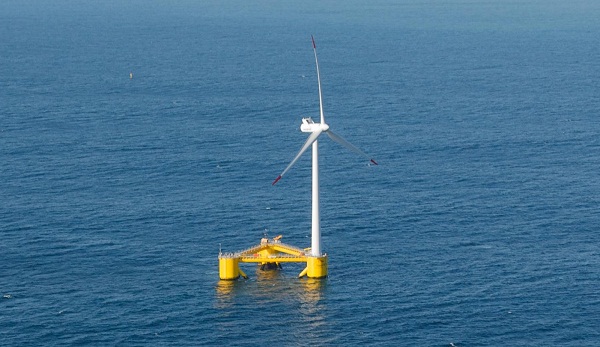A wind power project in waters off the Oregon coast took another step forward on Wednesday. It’s a project with loads of potential, but don’t get too excited yet – there’s still a long way to go before it’s a reality.
U.S. Secretary of the Interior Sally Jewell joined Gov. John Kitzhaber and other officials in Portland to announce the latest development for what could become the first West Coast offshore wind project: a determination by the feds of no competitive interest in a 15-square-mile area 15 to 18 miles off the coast at Coos Bay, where Principle Power wants to float five semi-submersible turbines, adding up to 30 megawatts in power generating capacity that would be connected to the shore by subsea cable.

The decision means the Seattle-based company can move forward on submitting a formal plan to the federal Bureau of Ocean Energy Management to build the pilot project, called WindFloat Pacific.
The project is, in one sense, a small part of an Obama administration push to permit 20 gigawatts of generating capacity on public lands. Most of the 13 gigawatts permitted thus far has been solar and wind power, but the administration is working hard to get offshore wind power going. Principle Power believes its project could point the way toward taking advantage of a vast Pacific Ocean wind resource.
“We think this could be a big deal,” Kevin Bannister, the company’s VP for business and government affairs, said in an interview. “This project has the real potential to influence discussions around renewable energy development on the West Coast.”
Once WindFloat submits its plan, the project will face environmental review, as well as consideration of its impacts on other stakeholders, some of whom have been cautious in endorsing the project.
So how long will it be before we can whip out our binoculars and see turbines spinning off the coast? WindFloat has been aiming to be up and running before the end of 2017, but everyone involved seems to recognize the uncertainties inherent in such a project. Jewell said that WindFloat “is really R&D” – no floating-turbine project of this scale yet exists, anywhere – and thus would require a deliberative process.
If wave energy’s experience in Oregon is any indication, patience will be required. Despite strong state support, a long-planned project by Ocean Power Technologies has yet to be deployed and looks increasingly in doubt as the company faces technology, financing and regulatory challenges.
In WindFloat’s favor, the company can point to a proven success: In 2012, its technology was used in a single-turbine floating project off Portugal and Bannister said that 2-MW turbine has “performed brilliantly.”
However, a couple of issues beyond possible environmental and stakeholder conflicts could come into play for WindFloat. In late 2012, Principle Power was one of seven offshore wind demonstration projects to receive up to $4 million apiece from the U.S. Department of Energy for engineering, site evaluation and planning work on WindFloat Pacific. The DOE said it would then offer perhaps three of the projects additional funding – worth up to $47 million over four years. There’s no certainty that money will be forthcoming.
Can the project happen without it?
Bannister didn’t answer that question, precisely, but said the money is “important,” and that the company was working to hit “all the milestones” necessary to win the grant.
A second question for WindFloat is how dependent it is on the proposed and controversial Jordan Cove LNG terminal at Coos Bay. The application for a commercial lease that Principle Power submitted last year [PDF] to the feds suggests an intimate connection with Jordan Cove. It states that “Power generated from the WindFloat Pacific project will be delivered to the Jordan Cove project in the Port of Coos Bay and will not be offloaded to the national electric grid” and that “the electric infrastructure being developed in association with the Jordan Cove project (the natural gas fired South Dunes Power Plant) created an obvious grid interconnection opportunity.”
However, BOEM Director Tommy Beaudreau, at the Portland announcement, said that while Jordan Cove was a “commercial consideration” for Principle Power, the project wasn’t strictly dependent on it. Bannister echoed that view.
“They bring infrastructure that would really help and make things easier and less expensive,” he said, “but that shouldn’t be confused with an interdependency.”
Bannister said Principle Power is negotiating a power purchase agreement with Jordan Cove. He didn’t hazard an estimate as to the value of the energy WindFloat might produce, but said that as a pilot project “we’re not going to be selling market rate electricity.”
While the U.S. still has no offshore wind power, the technology has been developed on a big scale in Europe, particularly by the U.K., using fixed-foundation turbines in shallow waters. The experience there has shown offshore wind to be a stubbornly expensive form of energy production, though advocates insist it will become cheaper over time, offering the advantages of larger turbines and better wind resources. Those are advantages that floating turbines, able to be stationed farther offshore in deeper waters – WindFloat would go in waters 1,200 feet deep – would theoretically magnify. Floating turbines might have yet one more edge, Bannister said: Since the turbines are built onshore and then towed into place, they don’t need massive and expensive deployment equipment.